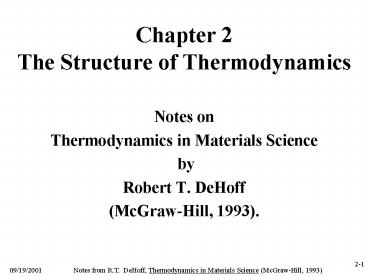Chapter 2 The Structure of Thermodynamics PowerPoint PPT Presentation
1 / 20
Title: Chapter 2 The Structure of Thermodynamics
1
Chapter 2The Structure of Thermodynamics
- Notes on
- Thermodynamics in Materials Science
- by
- Robert T. DeHoff
- (McGraw-Hill, 1993).
2
Thermodynamic Systems
- System --- That portion (subset) of the universe
that is under study. - Surroundings --- Everything else. Usually, only
the interaction with the immediate surroundings
is relevant.
3
Classification of Systems
- Unary versus Multicomponent --- How many unique
chemical species? - Homogeneous versus Heterogeneous --- How many
unique phases? - Closed versus Open --- Is matter exchanged with
the surroundings? - Non-reacting versus Reacting --- Can chemical
reactions occur? - Otherwise Simple versus Complex --- Are only
chemical, thermal, or mechanical effects
involved? Are fields, surfaces, or elastic
effects involved?
4
2.1 Classify the following thermodynamic systems
- A solid bar of copper
- Unary Multicomponent
- Homogeneous Heterogeneous
- Closed Open
- Non-reacting Reacting
- Otherwise simple Complex
5
2.1 Classify the following thermodynamic systems
- A glass of ice water
- Unary Multicomponent
- Homogeneous Heterogeneous
- Closed Open
- Non-reacting Reacting
- Otherwise simple Complex
6
2.1 Classify the following thermodynamic systems
- An yttria stabilized zirconia furnace tube.
- Unary Multicomponent
- Homogeneous Heterogeneous
- Closed Open
- Non-reacting Reacting
- Otherwise simple Complex
7
2.1 Classify the following thermodynamic systems
- A styrofoam coffee cup
- (just the polymer)
- Unary Multicomponent
- Homogeneous Heterogeneous
- Closed Open
- Non-reacting Reacting
- Otherwise simple Complex
8
2.1 Classify the following thermodynamic systems
- A styrofoam coffee cup
- (the polymer and enclosed gas)
- Unary Multicomponent
- Homogeneous Heterogeneous
- Closed Open
- Non-reacting Reacting
- Otherwise simple Complex
9
2.1 Classify the following thermodynamic systems
- A eutectic alloy turbine blade rotating at 20,000
rpm - Unary Multicomponent
- Homogeneous Heterogeneous
- Closed Open
- Non-reacting Reacting
- Otherwise simple Complex
10
Thermodynamic Properties
- State Variables --- Values are determined by
current condition are independent of path. - Process Variables --- Have meaning only for
changing systems. - Intensive Properties --- Have a value at each
point in a system. May vary from point to point.
Do not depend on the amount of matter. - Extensive Properties --- Values apply to the
whole system. Depend on the amount of matter.
11
2.2 Without state functions thermodynamics would
be useless. Discuss this assertion.
- If there no state functions (like T, P, V,
composition) then the behavior of all aspects of
matter would depend explicitly on the history of
the system. - There would be no variables that, by themselves,
explicitly describe the current condition of any
system. - Even the history experienced by the system could
not be described in terms of some sequence of its
properties.
12
2.4 Why is heat a process variable?
- Heat is fundamentally a flow of energy. Heat is
transferred between two systems, or between parts
of the same system. - The rearrangement of the distribution of energy
is accompanied by changes in at least some of the
properties of the system. - Such a change is a process
13
Thermodynamic Properties
- State Variables --- Values are determined by
current condition are independent of path. - Process Variables --- Have meaning only for
changing systems. - Intensive Properties --- Have a value at each
point in a system. May vary from point to point.
Do not depend on the amount of matter. - Extensive Properties --- Values apply to the
whole system. Depend on the amount of matter.
14
2.3 Determine which of the following properties
of a thermodynamic system are extensive/intensive
- The mass density.
- M/L3
- Kg/m3
Intensive Extensive
Intensive
15
2.3 Determine which of the following properties
of a thermodynamic system are extensive/intensive
- The molar density.
- M/L3
- Moles/m3
Intensive Extensive
Intensive
16
2.3 Determine which of the following properties
of a thermodynamic system are extensive/intensive
- The number of gram atoms of alumina in a chunk of
alumina. - M
- Moles
Intensive Extensive
Extensive
17
2.3 Determine which of the following properties
of a thermodynamic system are extensive/intensive
- The potential energy of the system in a
gravitational field. - ML2/t2
- J
Intensive Extensive
Extensive
18
2.3 Determine which of the following properties
of a thermodynamic system are extensive/intensive
- The molar concentration of NaCl in a salt
solution. - M/L3
- Moles/m3
Intensive Extensive
Intensive
19
2.3 Determine which of the following properties
of a thermodynamic system are extensive/intensive
- The heat absorbed by a gas in a cylinder when it
is compressed. - M L2/t2
- J
Intensive Extensive
Extensive
20
Thermodynamic Relations
- Laws --- 0th, 1st, 2nd, 3rd
- Definitions --- Energy, , Compressibility, ...
- Coefficient Relations --- Z Z(w,x,y,)
- Maxwell Relations ---
- Criteria for Equilibrium --- DS maximum
- Conditions for Equilibrium --- Ta Tb ,...

